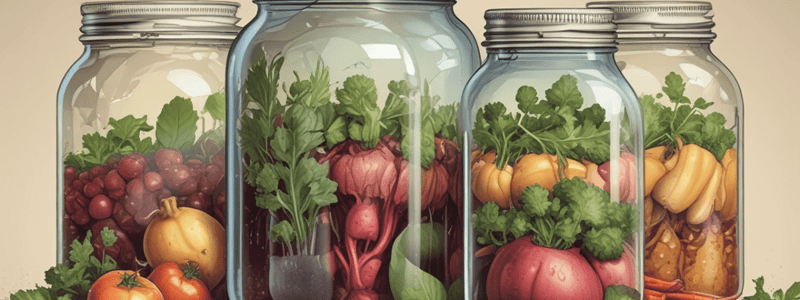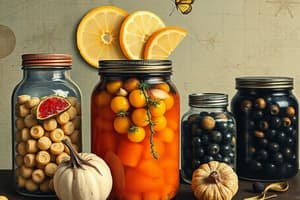Podcast
Questions and Answers
Which material should be avoided for drying fruits due to potential harmful residues?
Which material should be avoided for drying fruits due to potential harmful residues?
- Hardware cloth (correct)
- Plastic
- Wood
- Silicone
What effect does copper have on fruits during drying?
What effect does copper have on fruits during drying?
- Improves texture
- Increases shelf life
- Destroys vitamin C (correct)
- Enhances flavor
What is the maximum water activity (Aw) level at which most disease-causing bacteria can grow?
What is the maximum water activity (Aw) level at which most disease-causing bacteria can grow?
- 0.80
- 0.94 (correct)
- 0.99
- 0.91
Which food processing method employs both salt and sugar to prevent spoilage?
Which food processing method employs both salt and sugar to prevent spoilage?
How do salt and sugar inhibit microbial growth through osmosis?
How do salt and sugar inhibit microbial growth through osmosis?
Which of the following microbes is known to thrive at low water activity levels?
Which of the following microbes is known to thrive at low water activity levels?
What does the conversion of sugar to ethanol by yeast demonstrate?
What does the conversion of sugar to ethanol by yeast demonstrate?
Which component primarily inhibits the growth of most moulds?
Which component primarily inhibits the growth of most moulds?
What is the primary role of salt (sodium chloride) in food preservation?
What is the primary role of salt (sodium chloride) in food preservation?
Which of the following statements about drying fruits is correct?
Which of the following statements about drying fruits is correct?
Study Notes
Fermentation and Food Preservation
- Fermentation is a valuable food preservation method that not only preserves food but also creates more nutritious and palatable food from less desirable ingredients.
- Microorganisms responsible for fermentation can produce vitamins, resulting in a more nutritious end product from the ingredients.
Pickling
- Pickling is a preservation method that involves preserving foods in vinegar (or other acid).
- Vinegar is produced from starches or sugars fermented first to alcohol and then the alcohol is oxidized by certain bacteria to acetic acid.
- Pickling may have originated when food was placed in wine or beer to preserve it, and the resulting taste was appealing.
History of Pickling
- The Romans made a concentrated fish pickle sauce called “garum,” which was a powerful condiment.
- Ketchup was an oriental fish brine that traveled the spice route to Europe and eventually to America, where someone added sugar to it.
- Spices were added to these pickling sauces to make clever recipes, and soon chutneys, relishes, piccalillis, mustards, and ketchups were commonplace.
Curing
- The earliest curing was actually dehydration, where early cultures used salt to help desiccate foods.
- Salting was common and even culinary, with the choice of raw salts from different sources (rock salt, sea salt, spiced salt, etc.).
- In the 1800s, it was discovered that certain sources of salt gave meat a red color instead of the usual unappetizing grey, and consumers overwhelmingly preferred the red-colored meat.
Jam and Jelly
- Preservation with the use of honey or sugar was well-known to the earliest cultures.
- Fruits kept in honey were commonplace, and in ancient Greece, quince was mixed with honey, dried somewhat, and packed tightly into jars.
- The Romans improved on the method by cooking the quince and honey, producing a solid texture.
Canning
- Canning is the process of placing foods in jars or cans and heating them to a temperature that destroys microorganisms and inactivates enzymes.
- This heating and later cooling forms a vacuum seal that prevents other microorganisms from recontaminating the food within the jar or can.
- Canning is the newest of the food preservation methods, pioneered in the 1790s when a French confectioner, Nicolas Appert, discovered that the application of heat to food in sealed glass bottles preserved the food from deterioration.
General Principles of Traditional Food Preservation
- Food is preserved for various reasons, including taking care of excess produce, adding food variety, making transportation easier, and reaching areas where the food item hasn't reached.
- The general principles of traditional food preservation are preventing and delaying microbial decomposition, and preventing or delaying self-decomposition of food.
Methods of Traditional Food Preservation
- Fermentation started 7,000 years ago in Babylon and was used out of preference or necessity.
- Fermentation is the controlled decay of material using special bacteria that produce a more desirable product.
Microorganisms Used in Fermentation
- Strains of Streptococcus, Lactobacillus Bifidobacterium, Erwinia, etc. are used in the production of fermented food and dairy products.
- Molds are multicellular filamentous fungi that grow on foods, and they are mainly responsible for food spoilage at room temperature (25-30°C) and low pH.
- Yeasts have the ability to ferment sugars to ethanol and carbon dioxide, and they are extensively used in the food industry.
Preservation by Salt and Sugar
- Preservation by salt (sodium chloride) and sugar (sucrose) protects food from microbial spoilage.
- Salt and sugar not only prevent food spoilage but also inhibit or prevent the growth of foodborne disease pathogens.
- Salt and sugar inhibit microbial growth through osmosis and interference with the microbe's activity.
Studying That Suits You
Use AI to generate personalized quizzes and flashcards to suit your learning preferences.
Related Documents
Description
Learn about the benefits of fermentation in preserving and enhancing food, including the role of microorganisms in producing vitamins. This method also allows for creating more palatable foods from undesirable ingredients.




